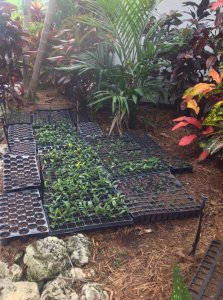annafl
Esteemed Member
- 2,243
- 24/02/13
- 567
- 153
I'm trying to learn to hybridize and I have so many questions, I'd love some advice from those of you who have had some experience with creating new cultivars. My first question is- how do you keep ants off a female inflorescence whose flowers are just starting to open so they don't get to them before you do?
Another question I have is- how do you select plants to hybridize? Obviously, one main criteria is that they have to have available male/female inflorescences. Other than that, how should your thought process go? I recently created seed from Raphael (seed parent) and Claude Lorraine (pollen). Is this a silly combination because they are so similar, or if I'd like to create pink, shade hybrids is this a good way to get a strong propensity for pink and doing well in shade? However, I'd also like there to be distinct differences in the new cultivars and larger leaves. Today I pollinated Diane (female) with Claude Lorraine (male), and Cutler's Gulfstream (female) with Claude Lorraine (male)
and larger leaves. Today I pollinated Diane (female) with Claude Lorraine (male), and Cutler's Gulfstream (female) with Claude Lorraine (male) , I have also pollinated Magnificent (female) with Claude Lorraine (male). Do you think these are good choices if I'd like to create large pink leaves in a shade hybrid?
, I have also pollinated Magnificent (female) with Claude Lorraine (male). Do you think these are good choices if I'd like to create large pink leaves in a shade hybrid?
Lastly, what media do you use for the seeds and how often do you water? How much sun do new hatchlings get?
Should we all get going on a lesson on hybridizing? We've got some outstanding people as sources out there. Come on, Jerry, Chris, Keith, and all others who have done thisHungryWriting! Help us, please !
!
Another question I have is- how do you select plants to hybridize? Obviously, one main criteria is that they have to have available male/female inflorescences. Other than that, how should your thought process go? I recently created seed from Raphael (seed parent) and Claude Lorraine (pollen). Is this a silly combination because they are so similar, or if I'd like to create pink, shade hybrids is this a good way to get a strong propensity for pink and doing well in shade? However, I'd also like there to be distinct differences in the new cultivars
 and larger leaves. Today I pollinated Diane (female) with Claude Lorraine (male), and Cutler's Gulfstream (female) with Claude Lorraine (male)
and larger leaves. Today I pollinated Diane (female) with Claude Lorraine (male), and Cutler's Gulfstream (female) with Claude Lorraine (male) , I have also pollinated Magnificent (female) with Claude Lorraine (male). Do you think these are good choices if I'd like to create large pink leaves in a shade hybrid?
, I have also pollinated Magnificent (female) with Claude Lorraine (male). Do you think these are good choices if I'd like to create large pink leaves in a shade hybrid?Lastly, what media do you use for the seeds and how often do you water? How much sun do new hatchlings get?
Should we all get going on a lesson on hybridizing? We've got some outstanding people as sources out there. Come on, Jerry, Chris, Keith, and all others who have done thisHungryWriting! Help us, please
 !
!
Last edited:

